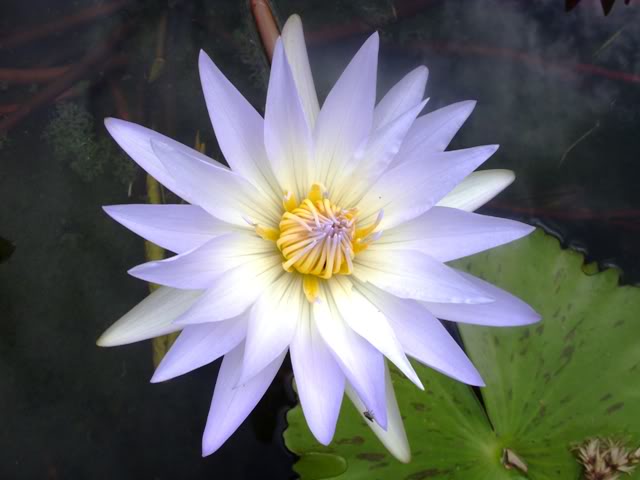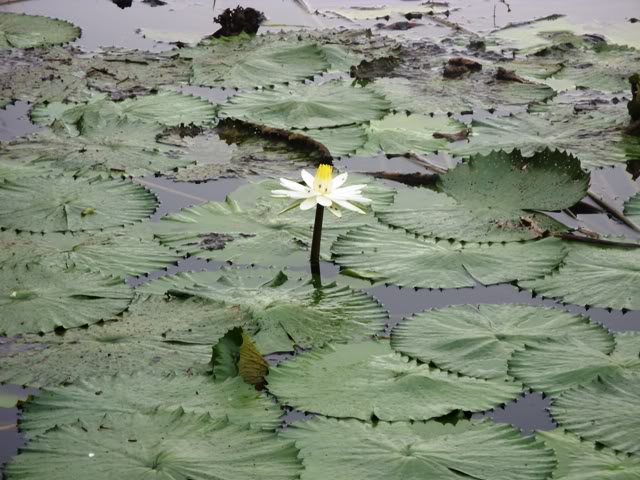Index to Flowers in the Order Nymphaeales
Family: Nymphaeaceae
Nymphaea nouchali Blue Water Lily https://africawild-forum.com/viewtopic.p ... 25#p170461
Africa Wild Flower Book - Order Nymphaeales
Moderator: Klipspringer
-
Poplap
- Posts: 1436
- Joined: Thu May 24, 2012 10:53 pm
- Location: Daar waar die bobbejane hul borshare kam...
- Contact:
Re: Africa Wild Flower Book - Order Nymphaeales
Blue Water Lily Nymphaea nouchali (Blouwaterlelie, Blou Plomb)
Order: Nymphaeales. Family: Nymphaeaceae


Description
It is a clump forming perennial with thick, black, spongy, tuberous rhizomes anchored in the pond mud by spreading roots. The water lily does not have true stems, the leaves are on long petioles (leaf stalks) that arise directly from the rhizome. The leaves are large and flat, rounded or oval in shape with notched margins, up to 40 cm in diameter, and cleft almost to the centre where the petiole is attached. They are relatively short lived and are replaced regularly throughout the growing season. They start out as a soft shiny green at the centre of the plant. As they age, the petiole lengthens, pushing the leaf towards the outer perimeter making room for the new growth, and they develop light brown or purple splashes which eventually cover the leaf, leaving only the veins green. They then start to die, turning yellow then brown and eventually disappearing under the water. One plant can spread over an area of about 1 m.
The leaves show many interesting adaptations to their watery environment. The margins are slightly rolled inwards toward the uppermost side (involute) which helps keep the blades afloat. The underside of the leaf, which is continually wet, has a strong attraction to the water and this holds the leaf flat against the water. The veins act like a structural support for the leaves. The upper leaf surface is coated with a smooth waxy cuticle, which gives it the appearance of being leathery and shiny. This water-repellent waxy layer is of vital importance to the plant, not only to help prevent the leaf from sinking, but also to prevent the tiny stomatal pores, through which it breathes, from becoming clogged with dust. When water splashes onto the leaf surface, it forms rounded droplets that roll across the surface cleaning up the dust as they go. Clean dust free leaves are also better able to photosynthesise effectively.
Another problem facing aquatic plants is the supply of oxygen to their roots. Roots must constantly be supplied with oxygen to stay healthy and the water lily's roots are buried in poorly aerated pond mud and therefore cannot get oxygen they way normal plants do. It has overcome this difficulty by developing a system of large internal ducts throughout the leaves, petioles and roots which ferries the oxygen from the leaves to the roots.
The large, elegant blue flowers are held well above the water at the tip of a sturdy green stalk and appear almost constantly from spring until the end of summer (September to February). They are bisexual, star-like and regular (actinomorphic), with 4 sepals, green on the outside and white to blue on the inside, and many blue petals. In the centre of the flower are numerous blue-tipped bright golden yellow stamens. There are colour forms other than blue that occasionally occur, e.g. white, mauve and pink, but blue is the most common and the water lilies at Kirstenbosch are blue. The flowers open in early to mid-morning and close completely in late afternoon and stay closed all night. The opening and closing mechanism of the flowers is controlled by the sepals. If they are removed, the flower loses the ability to close. A fully open flower measures 15-20 cm across and each flower lasts for about four days. The flowers are sweetly fragrant and are visited constantly by bees who are the most likely pollinator.
Order: Nymphaeales. Family: Nymphaeaceae


Description
It is a clump forming perennial with thick, black, spongy, tuberous rhizomes anchored in the pond mud by spreading roots. The water lily does not have true stems, the leaves are on long petioles (leaf stalks) that arise directly from the rhizome. The leaves are large and flat, rounded or oval in shape with notched margins, up to 40 cm in diameter, and cleft almost to the centre where the petiole is attached. They are relatively short lived and are replaced regularly throughout the growing season. They start out as a soft shiny green at the centre of the plant. As they age, the petiole lengthens, pushing the leaf towards the outer perimeter making room for the new growth, and they develop light brown or purple splashes which eventually cover the leaf, leaving only the veins green. They then start to die, turning yellow then brown and eventually disappearing under the water. One plant can spread over an area of about 1 m.
The leaves show many interesting adaptations to their watery environment. The margins are slightly rolled inwards toward the uppermost side (involute) which helps keep the blades afloat. The underside of the leaf, which is continually wet, has a strong attraction to the water and this holds the leaf flat against the water. The veins act like a structural support for the leaves. The upper leaf surface is coated with a smooth waxy cuticle, which gives it the appearance of being leathery and shiny. This water-repellent waxy layer is of vital importance to the plant, not only to help prevent the leaf from sinking, but also to prevent the tiny stomatal pores, through which it breathes, from becoming clogged with dust. When water splashes onto the leaf surface, it forms rounded droplets that roll across the surface cleaning up the dust as they go. Clean dust free leaves are also better able to photosynthesise effectively.
Another problem facing aquatic plants is the supply of oxygen to their roots. Roots must constantly be supplied with oxygen to stay healthy and the water lily's roots are buried in poorly aerated pond mud and therefore cannot get oxygen they way normal plants do. It has overcome this difficulty by developing a system of large internal ducts throughout the leaves, petioles and roots which ferries the oxygen from the leaves to the roots.
The large, elegant blue flowers are held well above the water at the tip of a sturdy green stalk and appear almost constantly from spring until the end of summer (September to February). They are bisexual, star-like and regular (actinomorphic), with 4 sepals, green on the outside and white to blue on the inside, and many blue petals. In the centre of the flower are numerous blue-tipped bright golden yellow stamens. There are colour forms other than blue that occasionally occur, e.g. white, mauve and pink, but blue is the most common and the water lilies at Kirstenbosch are blue. The flowers open in early to mid-morning and close completely in late afternoon and stay closed all night. The opening and closing mechanism of the flowers is controlled by the sepals. If they are removed, the flower loses the ability to close. A fully open flower measures 15-20 cm across and each flower lasts for about four days. The flowers are sweetly fragrant and are visited constantly by bees who are the most likely pollinator.
“Two things are infinite: the universe and human stupidity; and I'm not sure about the universe.”
― Albert Einstein
― Albert Einstein


